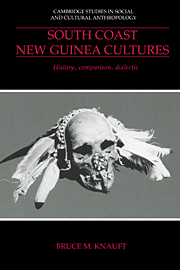Book contents
- Frontmatter
- Contents
- List of figures
- List of tables
- Acknowledgments
- 1 Language-culture areas of south coast New Guinea
- Part 1 Grounding
- Part 2 Critique
- 3 Sexuality in the regional analysis of south New Guinea
- 4 The analytic legacy of homosexual emphasis: language, subsistence, and political economy
- 5 Women's status
- 6 Trends in comparative analysis
- Part 3 Reconfiguration
- Appendix: evidence concerning Asmat homosexuality
- Notes
- List of references
- Index
- Cambridge Studies in Social and Cultural Anthropology
3 - Sexuality in the regional analysis of south New Guinea
from Part 2 - Critique
Published online by Cambridge University Press: 04 December 2009
- Frontmatter
- Contents
- List of figures
- List of tables
- Acknowledgments
- 1 Language-culture areas of south coast New Guinea
- Part 1 Grounding
- Part 2 Critique
- 3 Sexuality in the regional analysis of south New Guinea
- 4 The analytic legacy of homosexual emphasis: language, subsistence, and political economy
- 5 Women's status
- 6 Trends in comparative analysis
- Part 3 Reconfiguration
- Appendix: evidence concerning Asmat homosexuality
- Notes
- List of references
- Index
- Cambridge Studies in Social and Cultural Anthropology
Summary
Appadurai (1986, 1988) has suggested that pairing conceptual labels with ethnographic places easily compromises our understanding of local cultural variability. A few focal traits and their presumed correlates are often taken as metonyms to represent an entire ethnographic region, thereby reducing appreciation of its cultural richness and complexity. As these designators become routinized, they are easily taken for granted and used to generate or justify other idealized features attributed to the region. Concerning south New Guinea, strong emphasis has recently been placed on the indigenous practice of ritualized homosexuality or boy-insemination (Herdt 1984a, 1992; Lindenbaum 1984; Feil 1987:ch. 7). As will be discussed in chapter 4, these authors have also used male homosexuality as the conceptual centerpiece for analyzing a wide range of other presumed practices in south New Guinea, including a supposed dearth of competitive exchange, decentralized leadership, restricted marital reciprocity, and low (or high) female status.
Herdt's (ed. 1984) initial emphasis on south New Guinea ritual homosexuality was more than justified by the fact that homosexuality in Melanesia had been neglected for many years as a topic of comparative or theoretical study. Quickly, however, other writers have taken homosexuality as a point of orientation for south New Guinea as a whole.
- Type
- Chapter
- Information
- South Coast New Guinea CulturesHistory, Comparison, Dialectic, pp. 45 - 59Publisher: Cambridge University PressPrint publication year: 1993



